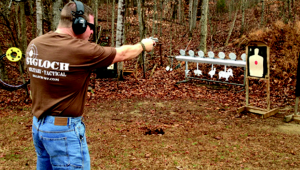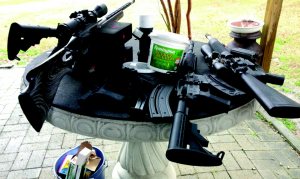by Chris Cerino
Back in the hills of North Carolina, on a balmy winter day, my family and a couple friends spent an entire day shooting in an informal setting. We set out to learn, reinforce, have fun and burn every .22 round we brought out.
Finding a day to shoot non-stop from morning to sunset is not an easy task.
Of course, finding the ammo is a whole other issue. Lucky for us we had a friend at Remington ammunition who wanted us to test one of their new tenpound Bucket O’ Bullets packs. We had 1,400 .22 golden bullets to begin our day. Until now, Remington led the industry with misfires when it came to their rimfire .22 ammo. Although this article isn’t about the ammo, but about what we did with it. An important note is that we did fire all ten pounds of that bucket without one single misfire or other failure.
On this day we had a variety of .22 caliber guns—AR15s, semi-auto pistols, revolvers and the ubiquitous Ruger 10/22s. Starting on paper, we shot bullseye targets for zero and then fired on a wide variety of all sizes of steel targets. With a 50 yard zero on the long guns we started to test ourselves, the guns and that Bucket O’ Bullets.
You can’t underestimate the practicality of working on fundamentals with .22 caliber guns. As if establishing zeros wasn’t enough to test our ability to make a sight picture and repeatedly press triggers in proper fashion, we decided to start doing it standing. We set a small rimfire dueling tree with two-inch plates out at 50 yards. The challenge was not only to hit the plates, but to do it from a standing position, hitting all six plates with six shots. Of course, my son, Colton, and friend, Dick Jones, were up to the task. Dick did it in just six. Colton did it in seven. Me? Maybe one or two more than that. Not an easy shot for anyone. Dick is a long time Camp Perry shooter and across-the course competitor. His fundamentals are precise and repeatable. Colton has an understanding of the fundamentals and the ability to control the human urge to anticipate or “capture the moment” that is uncanny. Never snapping the trigger but letting the sights drift naturally, applying pressure until the gun goes off, gets him amazing results. As for me, I’m good, but if I try too hard to beat either of them, I’ll surely miss.
Having various sized targets makes for great fun and challenge. Distance only adds to it. Now we would fire on the steel silhouettes Dick has hanging from a rack—the standard ram, turkey, pig and chicken. Ram being the largest and chicken the smallest, we worked our way back to 110 yards. The task here was to shoot not only standing but from positions as well. We were able to get good hits from standing, but it took time and there were some misses. Getting closer to the ground was what I needed to do so we moved to shoot from kneeling.
The closer to the ground you are the more stable you are. The more stable you are the more hits you get and the faster you can deliver accurate fire. Not a whole lot of missing going on from a solid, supported kneeling position.
Another great skill-set to have when competing, hunting or just target shooting is understanding trajectory.
Working on it when no living creature is subject to my error makes it fun. As the distance increased to 100 plus yards we had to start thinking about the trajectory of these little rim fire cartridges. Standard velocity .22 long rifle generally drops five to six inches over 100 yards. We figured our holds and of course started getting hits from the standing position. Some type of measuring reticle, like a mil dot system, really helps with consistency.
Not satisfied with slow aimed fire, we ended up in a very stable prone position. Once we settled in we rang steel as small as three inches square consistently from prone with all the fundamentals at play. Breathing, sight alignment, picture, trigger management and follow-through. Great practice at a fraction of the cost! After wearing out the steel with long guns we got out the pistols. Pistol craft is an important skill to have and a .22 caliber gun is a great way to build those skills. Working on the fundamentals of grip, sight alignment, sight picture and follow-through, we shot targets large and small at various speeds. Shooting groups on paper helped us establish point of impact and verified our fundamentals were solid. Getting hits on steel with pistols out to 50 yards is certain to make you feel good about your skills.
With a six-inch steel gong at 50 yards, there wasn’t one of us who couldn’t ring it repeatedly without a little coaching on the fundamentals.
After 1,400-plus rounds of shooting and switching between guns and shooters everyone gained a greater understanding of not only what it takes to hit, but why we miss. Although .22 ammunition is still a little scarce and prices have gone up, it’s still less expensive and just as practical for a day at the range.
Don’t let your skills fade because of ammo shortages and rising costs. The political future is uncertain and you can’t bank on anything coming back to what we thought before was normal. It is what it is and not likely to change.
You don’t need a wide variety of .22 caliber guns. However, you could get a rifle and a pistol that most closely resembles your large caliber guns.
Then get out for some fundamental reinforcement with those fun, inexpensive rim fires. Perhaps a Remington Bucket O’ Bullets is in your future! It’s all about the fundamentals!
Chris Cerino is a nationally known firearms instructor, competitor and TV personality who’s been training law enforcement officers and military for more than 12 years. Contact Chris by email at: info@cerinotraininggroup.com, by phone: 330-608-6415.





